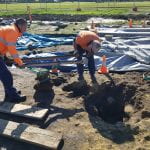We’ve just ticked over day three of the excavation – well, more like day two if Friday’s washout is not taken into account.
The five excavation crew arrived last week and, after a short period of acclimatisation, were thrown outside into the incipient Tasmanian winter to prove their mettle. After a day of removing compact gravel from old 2005 archaeology test trenches, an hour of being rained on and then some pleasantly warm weather, their mettle proves to be of iron – or, as we like to say in the business – ferrous.
Visitors to the excavation might not notice a huge amount of progress – which would be an uncharitable assessment. Those type of assessments should be left to the Supervisor, who, in this instance, is me. We’ve begun removing the remnant topsoil from the site, working from the higher section (south) toward the lower (north). This is so that we can expose the demolition layers underneath and record them, prior to removing those. These demolition layers were built up when the site was salvaged in the 1880s and then burnt in 1897. This means we are coming down to a lot of brick, mortar and sandstone rubble, as well as sections where convict period yards used to be. These are surfaced with broken dolerite (bluestone), an iron-hard stone which was broken by prisoners as a punishment task. Now, we’re digging it up (and we get paid).
This task is going to take us another one-to-two weeks, after which we’ll have a lovely clean site (I know, it seems like an oxymoron) ready for photogrammetric recording (more on that later).




Curious, and with all the questions – What sort of depth to the demolition layers are you seeing at this point? Was much left behind when Tolman purchased the buildings, or did he make a good show of clearing the site? Would there have been much left on the workshop site to burn in the fires, or would the fire remnants be more likely to be those of ruins of the Penitentiary?
Hi SW. My, one would think that you have some familiarity with the place. To answer your questions:
– we are coming down onto the demolition layers at the moment, so we unclear about the depths as yet. They will be deeper within the footprints of the buildings, as these were generally left as depressions after salvage, that were filled with demolition debris.
– it appears the 1880s salvage resulted in the removal of everything above ground. They left the footings in place, as well as yard surfaces.
– the charcoal we are seeing appears to relate to small vegetation – so likely the bushes and small trees that colonised the site after its abandonment.
A hint of familiarity, of course. And thank you, I know it is a sacrilege, but the Carnarvon era is always just that little bit more interesting.